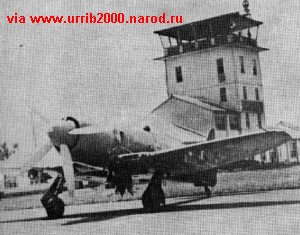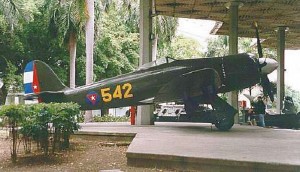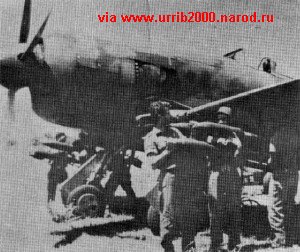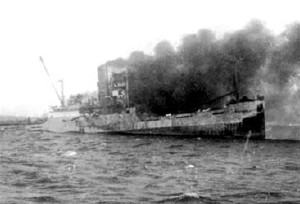

The Rage of the FuriesMario E. Overall |
 The Hawker Fury and its naval variant, the Sea Fury, were born as a decision taken
by Hawker to meet the Royal Navy and Royal Air Force requirements of a
powerful fighter-interceptor with only one air frame, although, with some
minor modifications between them. It was decided also that, Hawker should
develop the land based variant, while Boulton Paul Aircraft should take
over the development the carrier based one.
The Hawker Fury and its naval variant, the Sea Fury, were born as a decision taken
by Hawker to meet the Royal Navy and Royal Air Force requirements of a
powerful fighter-interceptor with only one air frame, although, with some
minor modifications between them. It was decided also that, Hawker should
develop the land based variant, while Boulton Paul Aircraft should take
over the development the carrier based one.
Over, Sea Fury with the colours of Batista´s Air Force. Below, a Sea Fury after the revolution in the San Antonio Air Base.

The first Sea Fury prototype flew on february 21, 1945. It was powered by a Centaurus XIII engine, driving a four bladed propeller. This prototype had an arrester hook for carrier landings, but retained fixed wings. Later, a second prototype was developed. It was powered by a Centaurus XV, driving a five bladed propeller. This prototype was the first to be equipped with full naval gear, including folding wings. On January 31, 1946 Boulton Paul Aircraft flew its first Sea Fury. It was completed to the same standard as the second prototype developed by Hawker.
At the end of the Second World War, RAF canceled all production contracts for the Fury, looking forward to acquire jet fighters. Accordingly the Royal Navy also reduced its order for Sea Furies to 100 aircraft, and canceled the Boulton Paul contract.
The first 50
production Sea Furies were desiganted MK X and were based basically on
the second prototype developed by Hawker. The first MK X flew for the first
time on september 7, 1946. At first, it was equipped with a four bladed
propeller, but after several trials, five bladed propellers became the
standard in all subsequent Sea Furies variants.

Hawker Sea Fury at the Revolution Museum in Havana.
The Sea Fury MK 11 variant was a fighter bomber version, capable of carrying two 1000kg bombs and twelve rockets, or two drop tanks or even two napalm tanks. The arrester hook was longer than those installed on the MK Xs, and the aircraft was equipped with gear for Jet Assisted Take Offs or JATO. More than 600 Sea Furies MK 11 were delivered to the Royal Navy, and remained as the fleet air arm�s principal single seat fighter until 1953.
The first unit to receive the Sea Furies (later redesignated as FB 11 instead of MK 11) was the 802 squadron in may 1948. 280, 804, 805 and 807 squadrons followed, embarking aboard the carriers Ocean, Theseus and Glory during 1949-1951.
The trainer
version of the Sea Fury was designated as T MK 20, and it was a direct
result of an order for four two seat Fury land based fighters for Iraq.
Later, the Royal Navy expressed interest in this version, and soon, Hawker
completed the first trainer meeting the Admiralty standards. This version,
initially, had two separate cockpit canopies, but during one of the test
flights, the rear canopy collapsed. After this incident, a tunnel for interconnect
the two cockpits was added to improve the mechanical strength. In addition,
a periscopic sight was installed just forward of the rear cockpit. The
armament was reduced from four to two 20mm cannon.
![]() Korean Interlude
Korean Interlude
When the
war broke in Korea in 1950, the Royal Navy carrier Theseus was deployed
to Korean Waters. The Sea Furies went into action against North Korea in
December 7, 1950, playing a key role on ground support duties. Later, the
Sea Furies were used for mine sowing outside the North Korean ports. In
several occasions the Sea Furies came under attack from Mig-15 jet fighters,
and several planes were shot down by the North Koreans. Although, some
of the Sea Furies did succeeded in destroying a number of the enemy jet
fighters. The Sea Fury squadrons aboard the carriers Ocean and Glory went
to action acouple of months later. Also the Royal Australian Navy carrier
Sydney was transferred and went into action with its Sea Furies. By mid
1953, the Hawker Sea Furies in service with the Royal Navy were replaced
by jet fighters.
![]() Foreign Service
Foreign Service
The first
export version of the Sea Fury was the MK 50 for the Royal Netherlands
Navy. At first, twelve aircraft were delivered, but by 1950, twenty four
were on strength. Later, Fokker was licensed by Hawker to produce the Sea
Fury. By the end of 1950, forty eight Sea Furies were on strength with
the Dutch Navy. The Dutch Sea Furies were not replaced until 1959 by Hawker
Sea Hawks.
During 1949, twelve Sea Furies were delivered to Egypt. A couple of these Sea Furies were still in service during the Suez operation in 1956. By the late 1949, Pakistan also ordered 93 Sea Furies and two trainers. Eighty seven of the single seaters were MK 60s, five were ex-Royal Navy MK 11s, and one was the older prototype in Hawker inventory. The two seaters were T MK 61.
During 1950, almost 50 ex-Royal Navy Sea Furies were transferred to the Royal Autralian Navy. Others were also supplied to the Royal Canadian Navy.
By 1957, large numbers of surplus Royal Navy Sea Furies MK10, MK11 and T MK20 were purchased back by Hawker. Of these, eighteen MK11 and three T MK 20 were refurbished and delivered to Burma.
In 1958, Hawker
selected fifteen Sea Furies FB 11 and two T MK 20 from the surplus re-purchased
batch. After refurbishement, the planes were crated and Hawker was ready
to deliver them. This time the destination was Cuba.
![]() Cuban Sea Furies
Cuban Sea Furies
When the
first ten Sea Furies (FAEC 500, 505, 510, 530, 541, 542 and 543 among others.)
arrived to Cuba in the late 1958, the Fulgencio Batista regime was in the
middle of a struggle, trying to put out several insurrection movements,
all courtesy of Fidel Castro�s Guerrilla Forces.

Enrique Carreras and his Sea Fury.
When the umarked crates were unloaded at the Havana docks, workers were stripped and searched before and after the operation, mainly due to the fear of sabotage. The operation for bringing operational the ten Sea Furies was taken by surprise by the overthrown of the Batista Government, the first airworthy aircrafts did not took active part in the final stage of the battle against Castro�s Forces before the overthrown, due to the lack of machine guns or any kind of armament. These were going to be delivered together with the final batch of seven Sea Furies that Hawker had programmed to deliver by the early 1959.
Shortly before the fall of the Batista regime, negotiations aimed to acquire ten more Sea Furies and a large order of 250lb. bombs, ammunition and rockets were initiated. Hawker offered to deliver those by february 1959, but with the events rapidly overtaking the Batista government efforts, the deal was never completed.
The Fulgencio Batista regime fell on January 1 1959, and Fidel Castro reached Havana on January 8 and gained control over all the military installations throughout Cuba. Soon, purges among the military officers were initiated by the Castro regime. In few days, over 1000 officers, including all the flying personnel, had been arrested. Only 43 pilots were found innocent of the war crimes charges. This lack of capable pilots was the ever present problem for Castro�s Air Arm until the late 60s.
Right in the middle of an organisational nightmare for the Castro�s government, the final batch of five Sea Furies FB11 and two T MK20 (FAEC 575 and 580) arrived in crates to Havana. Other equipment delivered by Hawker included 297 70in. rockets and 60,000 round of 20mm. ammunition.
By november 1959, only 12 Sea Furies were airworthy but their batteries were stolen as a result of an internal struggle in the Air Force. The other five were damaged beyond repair. Most of the other types like the F-47Ds, B-26Cs (Glass nose) and T-33As, were grounded due to lack of spares and maintenance staff.
By the early 1960, a team comformed by six mechanics from Hawker arrived to Cuba. Their mission was to bring operational again the Sea Furies. Their contract was for six months, with the possibility of extending this term to a year. On June 8 1960, an insurrection exploded within the Fuerza Aerea Revolucionaria, and soon, 28 pilots from the Sea Fury and B-26 squadrons were arrested. Once again the Sea Furies were grounded, relying only in the Hawker team to keep them airworthy. By that time, the Fuerza Aerea Revolucionaria had only six "politically reliable" pilots, being supported by six chilean jet pilots.
In february
1961, the Hawker team brought the surviving twelve Sea Furies airworthy.
But the supply of combat pilots remained short, there were only 25 of them.
Few of the F-47D were flyable at this time, and the combat force was conformed
by only four B-26Cs (from a total of 15), eight T-33As and the Sea Furies.
![]() In the skies over Girón
In the skies over Girón

Hawker Sea Fury 542, reloading ammo during the Bay of Pigs incident In the early morning of april 15 1961, eight CIA B-26B (Solid Nose), with Fuerza Aerea Revolucionaria markings but piloted by cuban exiled crews, took off from Happy Valley in Nicaragua and headed to Cuba. At 6:00 AM, the planes attacked La Libertad airbase where they destroyed a Sea Fury, among other planes. Seven people were killed. Later that same morning, another Sea Fury was destroyed in a hangar of the MOA bay mining company. Shortly after, the San Antonio de los Banos airbase and the Antonio Maceo airport were attacked by the B-26Bs. By the end of that day, the Fuerza Aerea Revolucionaria was left with less than half of its original air power. There remained only two B-26C, two Sea Furies, and two T-33A at San Antonio de los banos airbase, and only one Sea Fury at the Antonio Maceo airport. On the other hand, two of the attacking B-26 were damaged by ground fire, one of them managed to reach Key West with one engine feathered and low on fuel, and the other landed at Miami International Air Port in almost the same conditions.
Around 2:00 AM on april 17, the CIA/cuban exiled assault force reached the shore at Playa Giron but soon they were discovered by an army patrol. The soldiers alerted the nearing bases and several skirmishes broke up. The two surviving Sea Furies were deployed from the San Antonio airbase, and within fifteen minutes they were over the area, making several low passes and strafing the invading forces. When the FAR B-26Cs arrived and began to attack the invaders, the Sea Furies headed to the sea in search of the mother ships. Soon, they were located and the Sea Furies began to attack them. The Sea Fury FAR 541, piloted by major Enrique Carrera, damaged with rockets the command and control ship "Marsopa" and later, sunk the main supply ship "Houston". Now the invading forces had no command post and almost all the supplies of ammo, food and communications for the invasion were in the bottom of the sea with the "Houston".

The USS Houston after having suffered the Rage of the Furies. One of the Sea Fury (FAR 542), piloted by the nicaraguan Carlos Ulloa, was lost to AA fire from an invading ship while he was trying to shot down a curtiss C-46 of the invading forces. Soon after, the four T-33A arrived and began strafing the ships while they were trying to reach international waters. With the worsening of the situation for the invading forces due to the swampy terrain and the strong defense showed by the cuban Army, four B-26B were deployed from Nicaragua, but after entering the area, one was shot down by a T-33A and another by the Sea Fury piloted by maj. Carrera. A third B-26B was badly damaged by a Sea Fury (possibly FAR 543) piloted by Lt. Douglas Rudd. Both surviving B-26B managed to scape to Miami.
Near the end of that day, the Sea Fury 541, this time piloted by Gustavo Bourzac, strafed the invading ship "Rio Escondido" near international waters. From then on, the two surviving Sea Furies concentrated only on ground attack missions against the invasion forces.
Within the next 72 hours, the Fuerza Aerea Revolucionaria gained total air superiority over the invading force. By april 20, two more B-26B were shot down by the FAR�s T-33A, and on april 21, ten of their twelve B-26B were destroyed. Attempts to escort the bombers with Nicaraguan Mustangs were made by the invading force, but the idea was quickly discarded; the Mustangs could not reach Cuba, engage in combat and then return to Nicaragua. These planes just didn't had the range to do the job.
By wedneday
april 21, the invading troops were pushed back to their landing zone at
Playa Giron. Surrounded by the cuban army and constantly hammered by FAR
aircraft, some began to surrender while others fled into the hills. In
total 114 men were killed during the failed invasion.
![]() Epilogue
Epilogue
The Sea Furies, and the rest of the surviving combat types in service with
the Fuerza Aerea Revolucionaria, were replaced finally by june 1961 with
the arrival of at least 60 Mig-15 to the San Antonio de los Banos Airbase.
Later, several Mig-19 and Mig-17 followed the initial delivery.
The two surviving
Sea Furies are gate guardians to this date. One is located in the Playa
Giron Museum at Matanzas and the other is at the Revolution Museum in Havana.
Both wear very questionable color schemes, not related to the original
scheme used during the service years.
![]() Sources
Sources
- Book:
"The Hawker Sea Fury" by Francis K. Mason
- Book : "Central
American and Caribbean Air Forces" by Dan Hagedorn
- Book : "Foreign
Invaders" by Dan Hagedorn and Leif Hellstrom
- Book : "Operation
Puma" by Eduardo B. Ferrer
- Document
: "Joint Chiefs of Staff Memorandum 57-61, feb. 3 1961"
|
|
|
|
|||

|
|